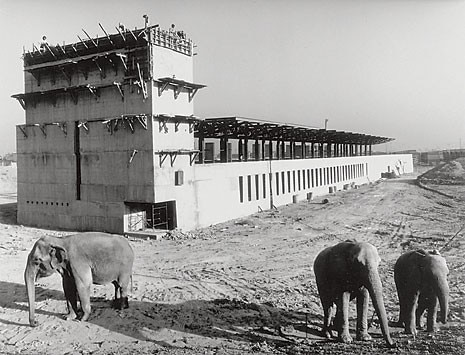Perhaps a lesser-known fact is that most of this population lives in the capital by day and, like a haemorrhage, leaves at the end of the day for the various suburbs. Twenty per cent of these “migrants” live on the eastern outskirts, in other words in Iztapalapa, one of the city’s poorest and most violent areas. In this setting lies FARO, the Fábrica de Artes y Oficios de Oriente. The Centre’s premises, designed by Alberto Kalach, are located in the drained basin of Lake Texcoco. The building dates back to the early 1990s and was erected to house a number of government offices, but the project remained unfi nished and the entire area became a dumping ground. A few years later a group of intellectuals submitted a proposal to the new left-wing administration to reclaim and redevelop the whole area and transform the building into an arts centre for the Iztapalapa community. Converted for its new purpose, the Kalach building metaphorically takes the shape of a ship, and in 2000 it officially set off on its course. For the fi rst time the Ciudad witnessed the birth of a decentralised cultural project, in other words one outside the city centre, where one loses one’s voice and has no presence.
So how do you involve people in the definition of a cultural project when they have always been unforthcoming? The answer to this pressing question can be found in the mural that runs around the outside of the building. Coordinated by the Neza Arte Nel collective of mural-graffi ti artists, it was created with the involvement of a substantial part of the community. This operation immediately created a sense of belonging, and the place has quickly become a rendezvous for creative production: almost 1,500 people take part in workshops each year, around 40 every three months. The courses are not the only free services offered. There is also a library with 16,000 books, a cinema, an exhibition space, a ludoteca and a piazza that can hold 10,000 people. The Fábrica, however, is not just a local project, as demonstrated by the presence of 150 artists who come from all over the world to confront and work in this context. The FARO offers a good example of how artistic practice can play a role in social transformation, turning public space into social space, or rather a space that in order to exist requires the act of “doing” via the subjectiveness of people. But it also shows that residual urban territory can be a fertile, participatory terrain for creating other ways of life. This is such an unprecedented project that the Government Secretary for Culture, who until a short time ago had the role of discrete sponsor, has taken over the management and begun a real process of institutionalisation. Furthermore, the model has been exported to other parts of the city, activating a real network of FAROS. Alessandra Poggianti
http://www.farodeoriente.org


